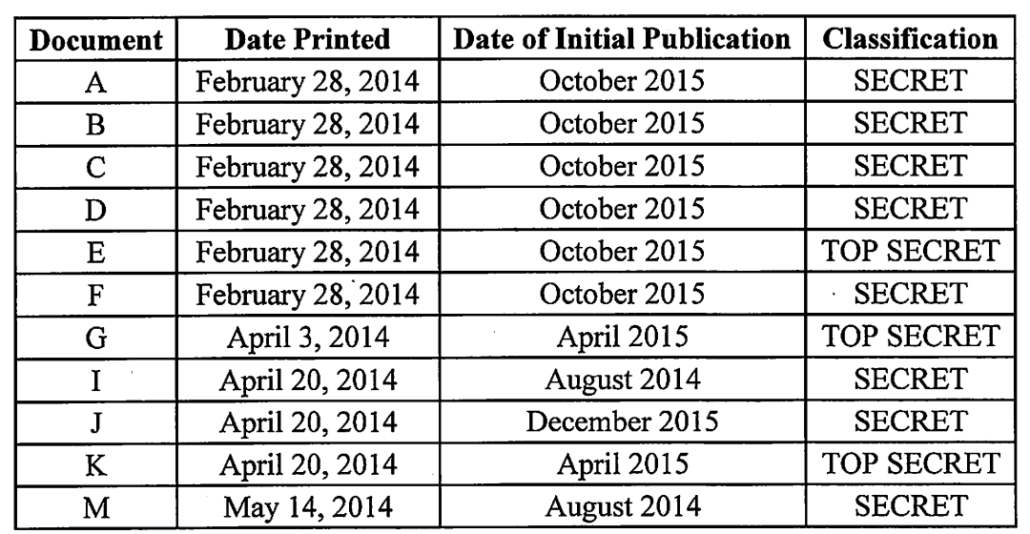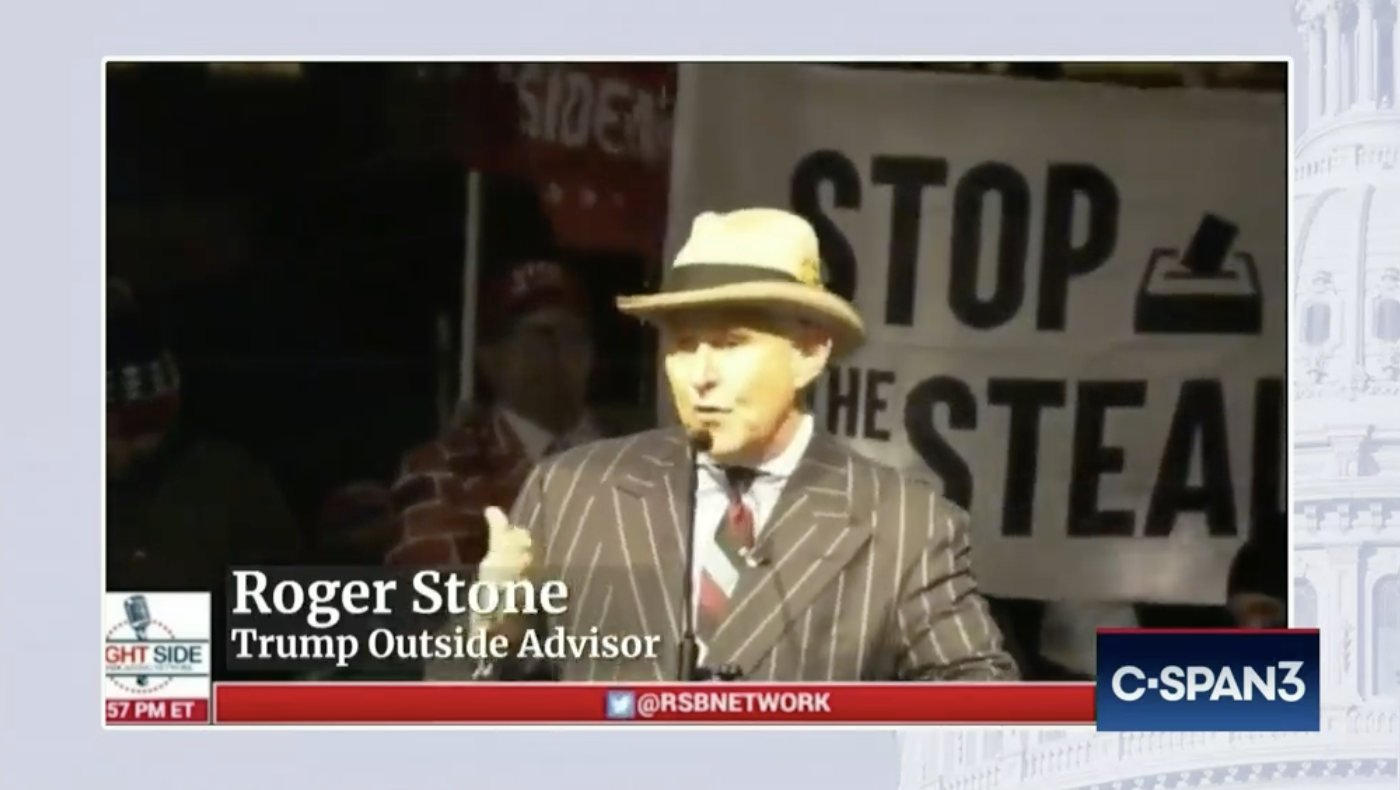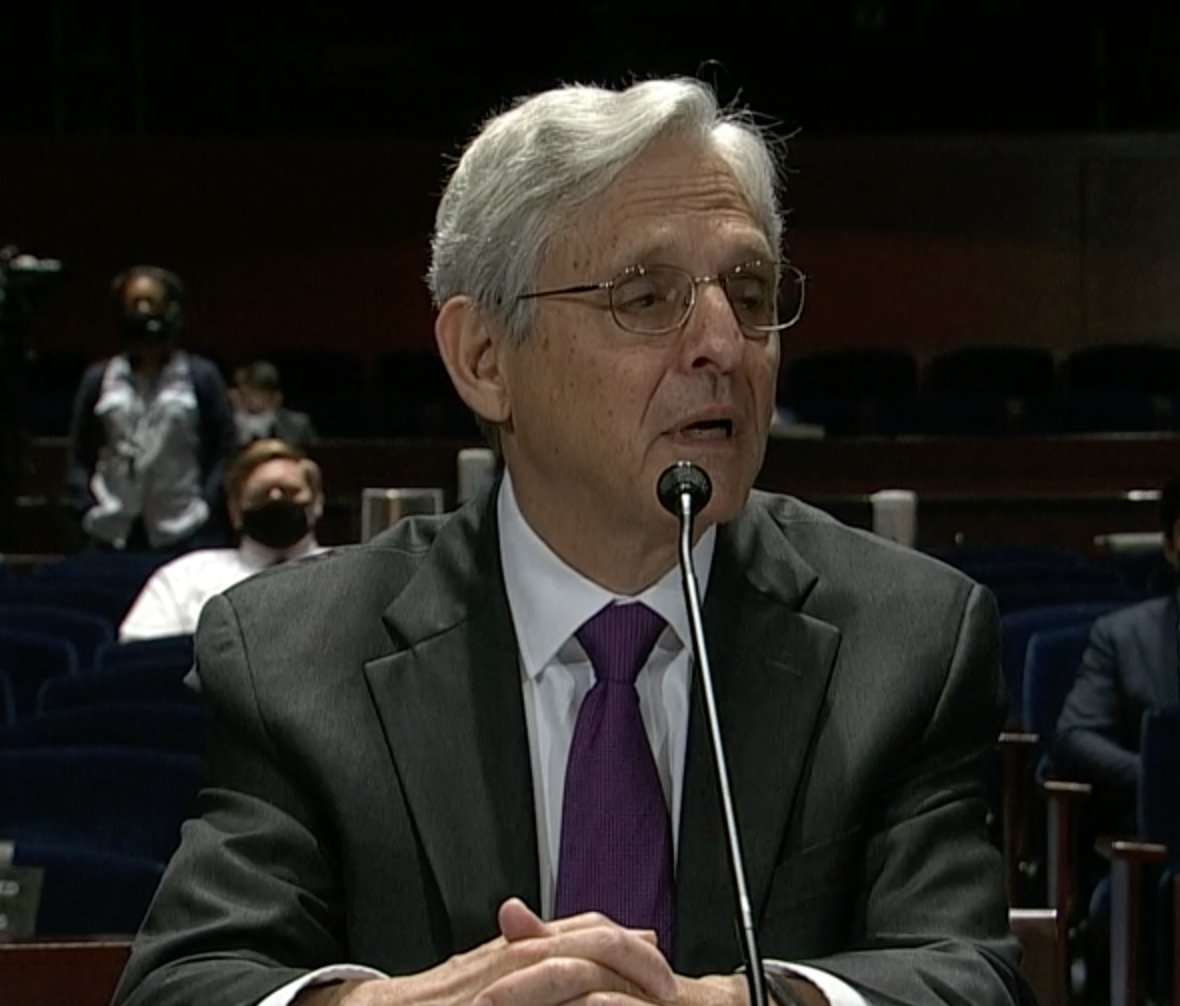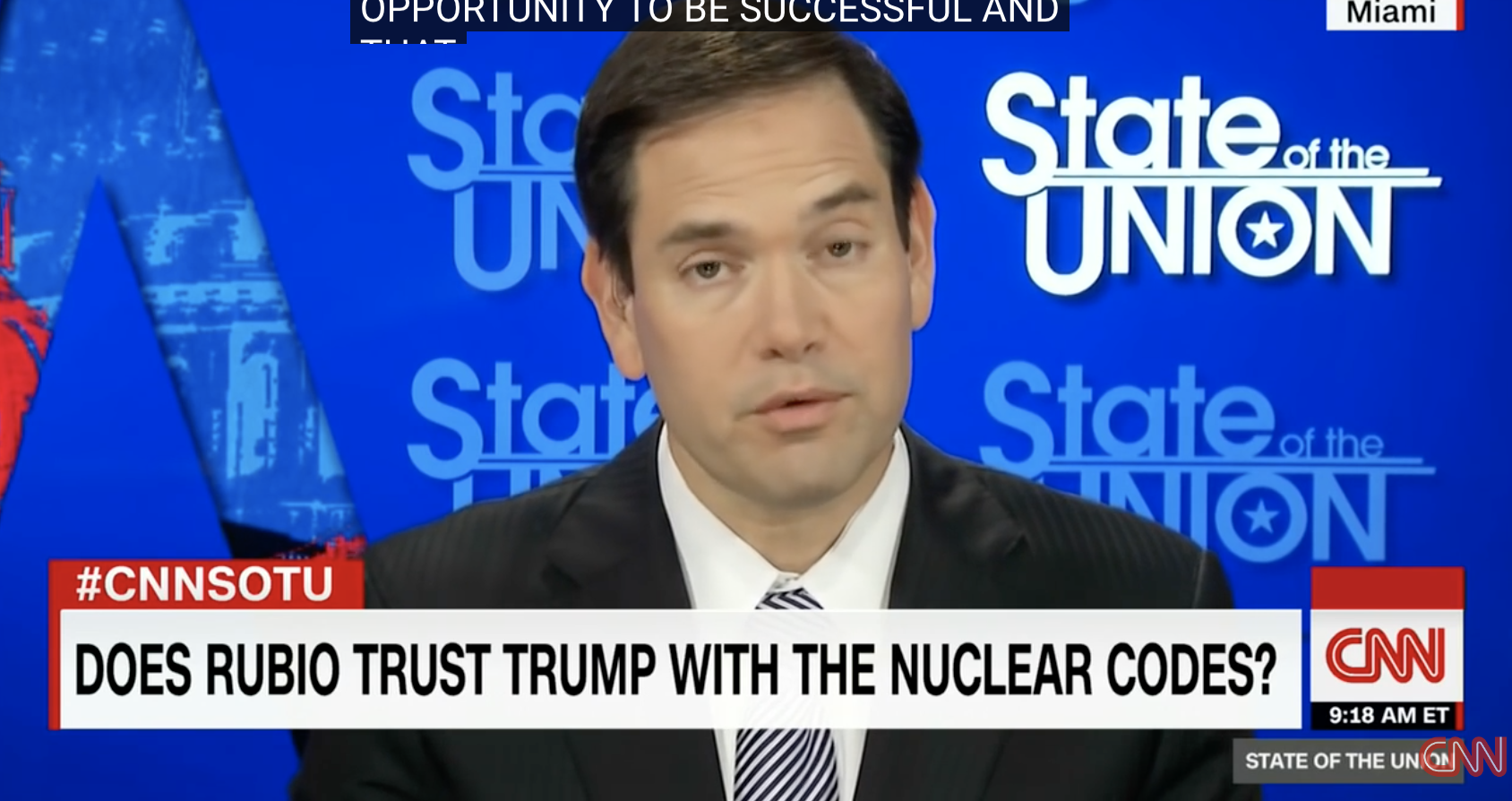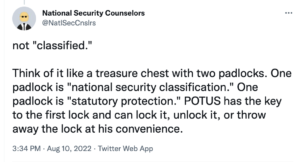There are two separate receipts for the search of Mar-a-Lago signed, in the same minute, by Trump lawyer Christina Bobb.
There’s the one consisting of five boxes and a separate category, “Documents,” not associated with any boxes, signed by the Supervisory Special Agent. There are no classified documents described. I’ll refer to that as the SSA Receipt in this post.
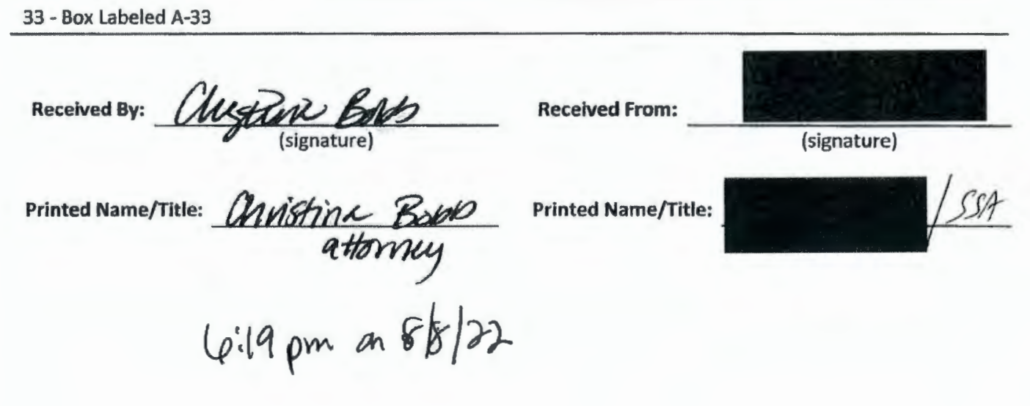
Then there’s the one that consists of 27 items, mostly boxes, many with sub-items, which are often descriptions of the kinds of classified documents contained in the box or the leather case they were seized in. It was signed by a Special Agent. I’ll refer to that as the CLASS Receipt in this post.
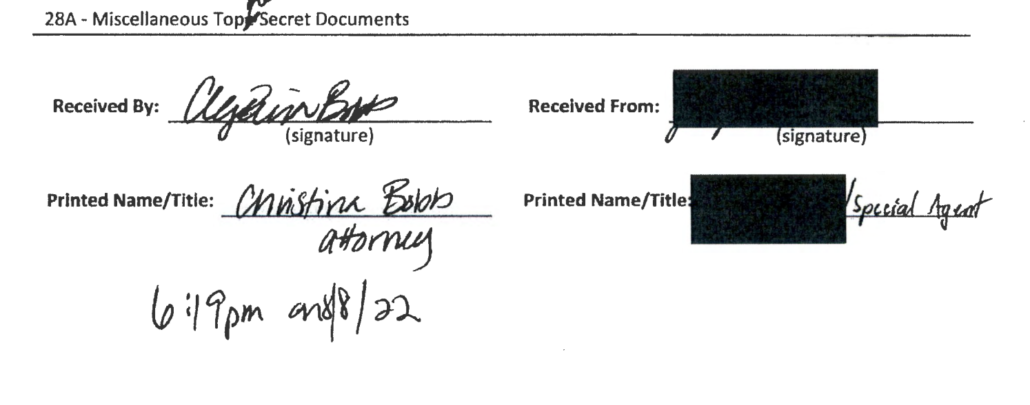
Bobb signed them both at 6:19PM, so unless she’s a shitty lawyer, these receipts were presented to her together as one running receipt.
Whatever else the FBI is, their searches are methodical. They come in, secure the location, serially take pictures of the rooms being searched (so the criminal suspects don’t claim evidence was planted, as criminal suspects are wont to do), label the things to be searched, start sorting through items according to a search protocol to see if they’re covered by the warrant, then inventory the things being seized. In this case, there would have been another part of the process to make sure no attorney-client privileged materials were seized.
In the search of Trump’s house, at least 73 boxes appear to have been labeled (based on the highest box label number), but just 26 boxes were seized.
By all appearances, these two receipts stem from the same methodical search. For example, the documents listed as item 4 on SSA receipt are in the same overall inventory as everything else, but appear out of sequence. They likely bear some proximal relation to low-item numbers in the CLASS receipt — things like the Roger Stone clemency and the binders of photos. Perhaps they were all found in Trump’s office or residence. But they are on the SSA receipt.
The series of box labels crosses both receipts. For example, it appears that boxes A-14 and A-13, which appear in the SSA receipt, were labeled in close proximity and time as boxes A-12 and A-15, which are among the lowest numbered boxes on the CLASS receipt. But they got listed on the SSA receipt, where all boxes appear together as the final five items on the combined inventory, items 29 through 33.
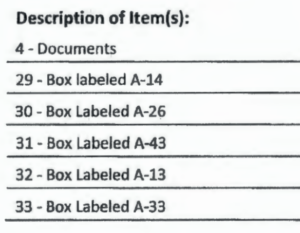
I’d like to talk more about the search, but first let me spoil the punchline: One likely (though not the only) explanation for the two receipts has to do with the venue in which Trump’s suspected crimes were committed and therefore the ultimate destination of the seized materials, with the SSA receipt materials being sent to DC as evidence of 18 USC 1519 and the CLASS receipt materials being kept in Miami as evidence of multiple violations of the Espionage Act that occurred at Mar-a-Lago.
But let’s go back.
I believe this warrant is the totality of the search on Trump’s mansion. While File411 suspects there’s another warrant (or two), I don’t believe those authorize a search of Trump’s house, not least because Judicial Watch has only asked to unseal one, and Trump’s people will have told them what they wanted unsealed. Merrick Garland referred to unsealing the documents relating to Trump’s house, and I’d be surprised if he played word games to hide further search materials when Trump would literally have receipts to call out any such obfuscation. That doesn’t rule out that the other warrants identified by File411 were related searches, perhaps of locations where Trump’s stolen documents may have been moved, but I believe we’re looking at the totality of the physical search at Mar-a-Lago. Update, August 15: DOJ has now confirmed that this is an entirely separate ongoing investigation. Remember that lots of January 6 suspects live in Florida, so it could be something like that or an entirely different type of crime.
The warrant authorizes the FBI to search Trump’s office (the narcissist appears to have renamed it the 45 Office but it has been referred to as the bridal suite), all storage rooms (the one that Trump’s lawyers showed Jay Bratt when he visited in June is not identified by name), and anywhere else Trump or his staff might have stashed boxes or documents. We know from reports that that included Trump’s personal residence, but the FBI didn’t call it out by name. Curiously, the FBI made clear that when it said the search did not include spaces occupied by guests or other residents, they mean “currently,” as if there’s a room someone recently vacated that is of interest.
Attachment B, which describes the items to be searched for, is one of the things that may explain the two receipts. It starts by listing three crimes: 18 USC 793 (Gathering, transmitting or losing defense information, which is part of the Espionage Act), 18 USC 2071 (Concealment, removal, or mutilation [of official records] generally), and 18 USC 1519 (Destruction, alteration, or falsification of records in Federal investigations).
Despite the fact that every single leak to the press about the scope of the warrant claimed that two crimes were listed, “mishandling classified information” and the Presidential Records Act, those leaks were all false. The former was a transparent attempt to avoid saying the word “Espionage” and the latter is not listed on the warrant as a crime being investigated at all (though I would bet a great deal of money that it features prominently in the affidavit). 18 USC 2071, in this context, may serve as a proxy, criminalizing the removal of records covered by PRA. And one of the four bullets describing materials that can be seized, bullet c, stems from PRA: “Any government and/or Presidential Record created between January 20, 2017, and January 20, 2021.” Because it would cover items implicated in the two other crimes, National Defense Information and evidence from Federal investigations, that bullet point serves as a larger umbrella in this search. If Trump tries to claim he declassified the items seized in the Espionage Act investigation, for example, the government will be able to say they still seized them lawfully given that bullet point and the inclusion of 18 USC 2071, because to still be at Mar-a-Lago at this point, they would have had to have been removed improperly from government control.
There are two bullet points scoping out materials relating to the Espionage count. Bullet point b authorizes the seizure of information about the storage of NDI or classified information.
Information, including communications in any form, regarding the retrieval, storage, or transmission of national defense information or classified material.
If Trump or his flunkies are charged under the Espionage Act, DOJ will have to rebut the claims being floated by Kash Patel and John Solomon that Trump declassified this material. One way to do that is to show that Trump or his lawyers instructed staffers to treat certain materials as if it was classified. If, for example, Trump put up post-it notes on his storage room saying “Danger: Sekrits. Keep Out,” it would prove that he was telling others to treat the documents with care. I’m only partly joking. We know there were efforts to prevent uncleared staffers from looking at classified information. Obtaining written proof of such instructions is one of the ways DOJ would prove that Trump did know this stuff remained classified. Even if those efforts were only enforced by his lawyers — the same lawyers who failed to turn over these materials in response to subpoena — it will be powerful evidence that those documents were being treated as if they remained classified.
The other bullet point authorizing evidence covered by the Espionage Act reminds me of Borges’s writings on classification.
Any physical documents with classification markings, along with any containers/boxes (including any other contents) in which such documents are located, as well as any other containers/boxes that are collectively stored or found together with the aforementioned documents and containers/boxes.
Effectively, this allows the FBI to seize documents with classification markings and then work out from there, seizing the box containing the document marked as classified, as well as the contents of the closet that a box containing a classified document was in. It’s fairly easy to understand why the FBI wrote it this way (and it may be tailored to overcome the justifications Trump made over the course of 18 months to try to retain certain materials). The President looks at — and in many cases, generates — a whole slew of things that are considered highly classified, but in a form that wouldn’t have classification marks on it, especially if he never shared it with a staffer. If Trump took notes with his Sharpie on a cocktail napkin during a phone call directly with Mohammed bin Salman, for example, it would not include classification marks, but it might be highly classified. So this bullet point allows FBI to seize stuff being treated the same way as documents that do have formal classification markings, which government classification experts can then apply the appropriate classification to.
How this might have worked in practice appears on the CLASS receipt. The second-most interesting item on the list (after the Roger Stone clemency that seems to have some tie to the French President) is the leather box in which the only documents inventoried as TS/SCI were stored.

Not all of these documents are TS/SCI; the inventory even notes that some are just classified. But given the way the warrant is written, the FBI was permitted to seize the entire box, which appears to contain Donald’s precious treasures, even if some of the documents in there are not labeled as classified. It may be that witnesses told the FBI of the existence of this box so the FBI knew to look for it. By seizing the entire box, the FBI would get things that might be even more sensitive than the TS/SCI stuff, but that don’t bear markings, like that hypothetical cocktail napkin with notes of Trump’s secret calls with MbS.
The thing is, these categories overlap. There may have led to some triage onsite about how to classify seized documents. I suggested that item 4 — documents — may have been stored with items 1 through 7 in Trump’s office or residence. If so, they could have been seized by proximal location. But they’re inventoried on the other receipt for some reason, potentially even taken out of a box or that leather case and seized separately as individual documents.
Similarly, boxes A-13 and A-14 were likely stored in close proximity to box A-15, which includes at least some Secret Documents, and box A-16, which includes at least some Top Secret Documents. So they could have been seized under the logic of proximity. But like item 4, they’re on a different receipt.
Which brings me to the final bullet describing the scope of the search (and back to my working hypothesis for the two different receipts, that the SSA receipt covers evidence of obstructive acts committed in DC). It authorizes the seizure of evidence of the destruction of records.
Any evidence of the knowing alteration, destruction, or concealment of any government and/or Presidential Records, or of any documents with classification markings.
This language comes right out of the obstruction statute, though leaves out the reference to “investigation[s] or proper administration:”
Whoever knowingly alters, destroys, mutilates, conceals, covers up, falsifies, or makes a false entry in any record, document, or tangible object with the intent to impede, obstruct, or influence the investigation or proper administration of any matter within the jurisdiction of any department or agency of the United States or any case filed under title 11, or in relation to or contemplation of any such matter or case, shall be fined under this title, imprisoned not more than 20 years, or both.
This part of the warrant, not the reference to the Espionage Act, was the biggest secret of the week. I was not surprised that anonymous sources from the Trump camp soft-pedaled the word “Espionage.” It’s why I was pushing for pressure on Trump to release the warrant. It’s what I believed Trump most wanted to hide.
But remarkably, Trump’s leakers were hiding this part of the warrant even more aggressively. In the entire week of post-search coverage, there was never a hint that obstruction was on the warrant, too. The “Expert Explainers” gaming out what crimes might be on the warrant completely missed obstruction. I did too.
We shouldn’t have. The coverage of the Archives’ referral of Trump to DOJ described his destruction of evidence even more prominently than it did his theft of classified documents.
The National Archives and Records Administration has asked the Justice Department to examine Donald Trump’s handling of White House records, sparking discussions among federal law enforcement officials about whether they should investigate the former president for a possible crime, according to two people familiar with the matter.
The referral from the National Archives came amid recent revelations that officials recovered 15 boxes of materials from the former president’s Mar-a-Lago residence in Florida that were not handed back in to the government as they should have been, and that Trump had turned over other White House records that had been torn up. Archives officials suspected Trump had possibly violated laws concerning the handling of government documents — including those that might be considered classified — and reached out to the Justice Department, the people familiar with the matter said.
[snip]
Trump’s years-long defiance of the Presidential Records Act, which requires the preservation of memos, letters, notes, emails, faxes and other written communications related to a president’s official duties, has long raised concerns among historians and legal observers. His penchant for ripping up official documents was first reported by Politico in 2018, but it has drawn new scrutiny in recent weeks because of a House select committee’s investigation of the Jan. 6, 2021, attack on the U.S. Capitol.
The Washington Post reported late last month that some of the White House records the National Archives turned over to the committee appeared to have been torn apart and then taped back together. The Post later found — and the Archives confirmed — that officials had recovered 15 boxes of presidential records from Mar-a-Lago.
As described, by the time of its criminal referral, the Archives had already found that documents that were responsive to the January 6 Committee’s investigation (and so, derivatively, DOJ’s investigation of Trump personally) had been “altered, destroyed, or mutilated.” DOJ would have started this investigation knowing that Trump had attempted to destroy evidence implicating him in January 6 (though we actually have evidence of him attempting to destroy or alter evidence pertinent to other criminal investigations, too).
By description, when Trump tried to destroy evidence, he did so immediately, in the heat of the moment, in the White House. For that reason, and because the known federal investigations — his attempted coup on January 6, but also his ties to Russia, his coercion of Ukraine, even his inauguration graft — were all predicated in DC, the investigation into Trump’s obstruction of those investigations would be in DC too. That’s why I hypothesize that FBI may have inventoried everything and then, when compiling a final inventory to share with Trump, they distinguished between the suspected crimes that would have been committed in Florida, by storing classified information improperly and refusing to return it to the Federal government, and the suspected crimes that would have been committed in DC when — on January 20 or before, including between January 6 and January 20 — Trump ripped up, flushed, burned, or tried to eat incriminating evidence.
Unless Trump were to waive venue (which he would never do), any prosecution of Trump under the Espionage Act would happen in SDFL, because that’s where he illegally retained classified information after the government asked him to give it back. But any prosecution of Trump for obstruction would happen where the investigations he obstructed were and where he ripped up evidence, in DC.
Item 4, documents, might just be documents that bore visible signs of destruction that had some identifiable tie to January 6 or some other known investigation. They could even be classified! The obstruction bullet point includes classified documents! But they would have been seized, first and foremost, because they were evidence that Trump was trying to impede an investigation or some other government function by destroying evidence.
That has one more big implication, which may be why Trump’s team tried so hard to hide that FBI was looking for evidence of obstruction. There were also leaks (including leaks from the government side) that nothing on this search warrant pertains to January 6. Technically that’s true. Obstruction of the vote certification and conspiracy to defraud the government, the most obvious crimes covering Trump’s conduct leading up to and on January 6, aren’t on the warrant. But as that coverage of the original referral we all forgot to read makes clear, January 6 is at least one of the investigations that Trump is being investigated for obstructing. If the evidence of obstruction is being boxed up and sent back to DC where such an investigation would be predicated, then the evidence would thereby become available to investigators, both for evidence of Trump’s obstruction of an investigation, but also for evidence of Trump’s conduct as well.
Oh. And if Trump were found to have obstructed an investigation into conspiracy by destroying evidence, it might extend the statute of limitations on that conspiracy.
I wrote a long thread yesterday about how Trump epically fucked up by giving DOJ grave reasons to come search his home. DOJ would never have searched Mar-a-Lago for materials Trump withheld in violation of the PRA. They probably would never have searched MAL for evidence he withheld regarding January 6. But Trump kept refusing to turn over classified information DOJ knew he had, some of it reportedly incredibly sensitive. Trump dared Merrick Garland to come get those classified documents. And in so doing, Donald J. Trump gave the FBI urgent reason to come into his home to seize — along with at least 11 boxes containing classified documents — the evidence about January 6 and other investigations that is so sensitive Trump tried to destroy it before refusing to turn it over to the Archives.

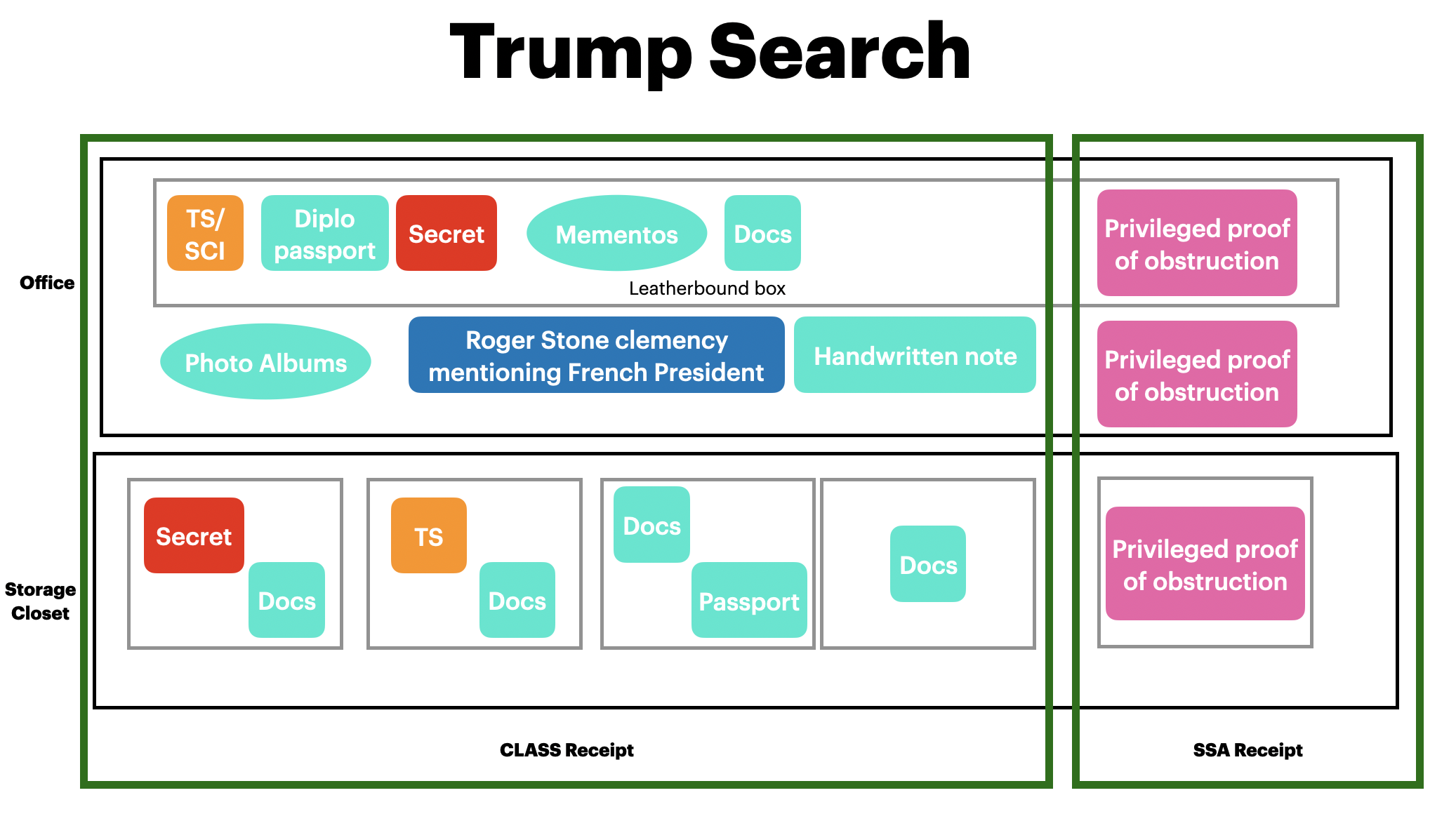
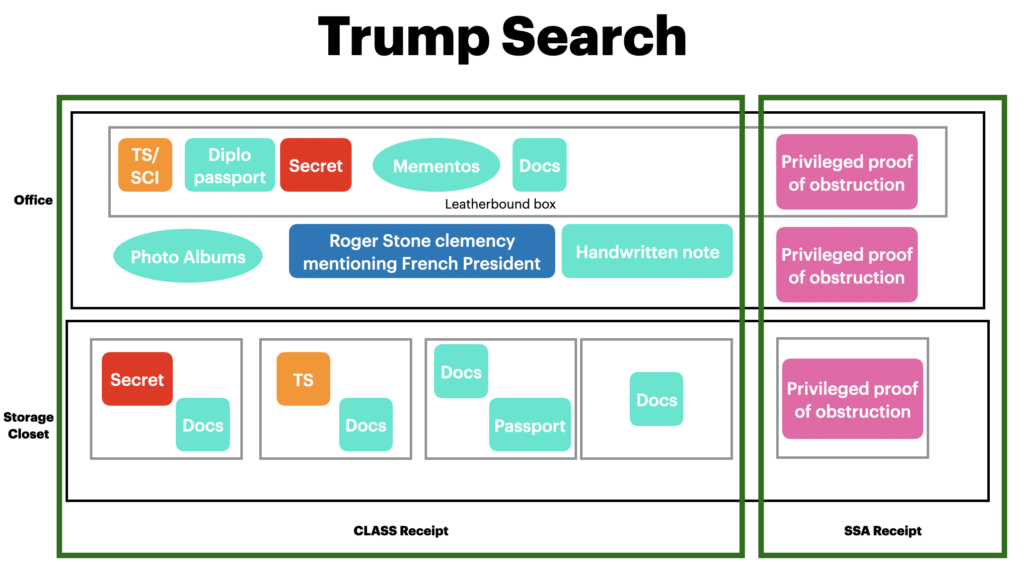
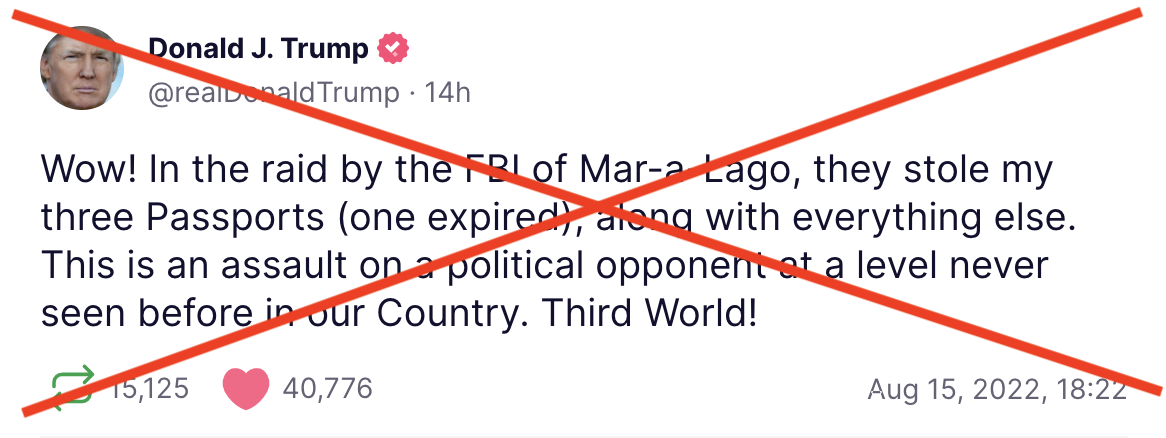
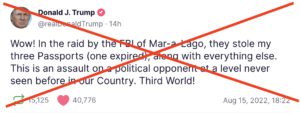
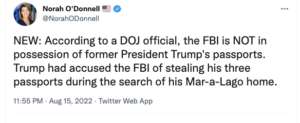
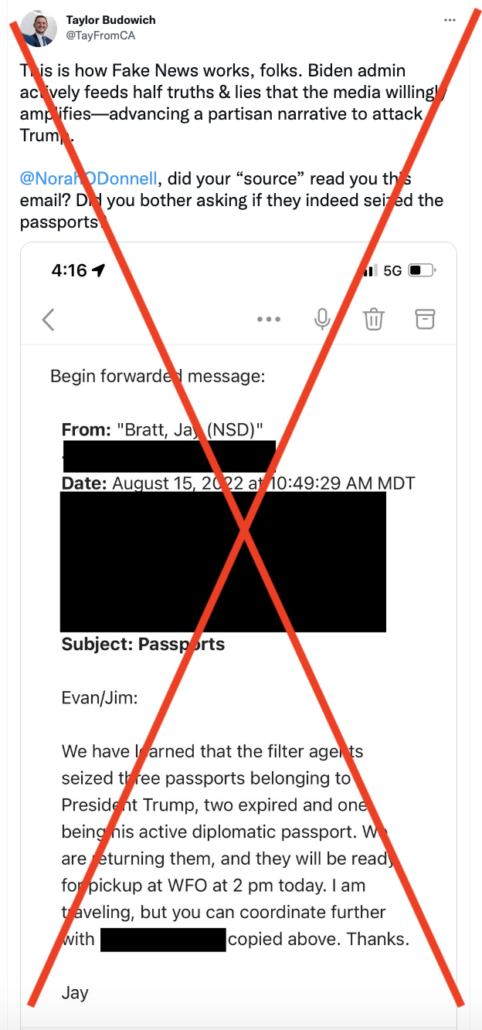

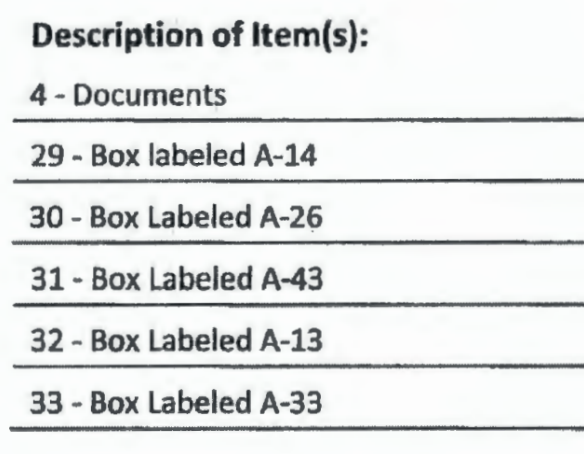
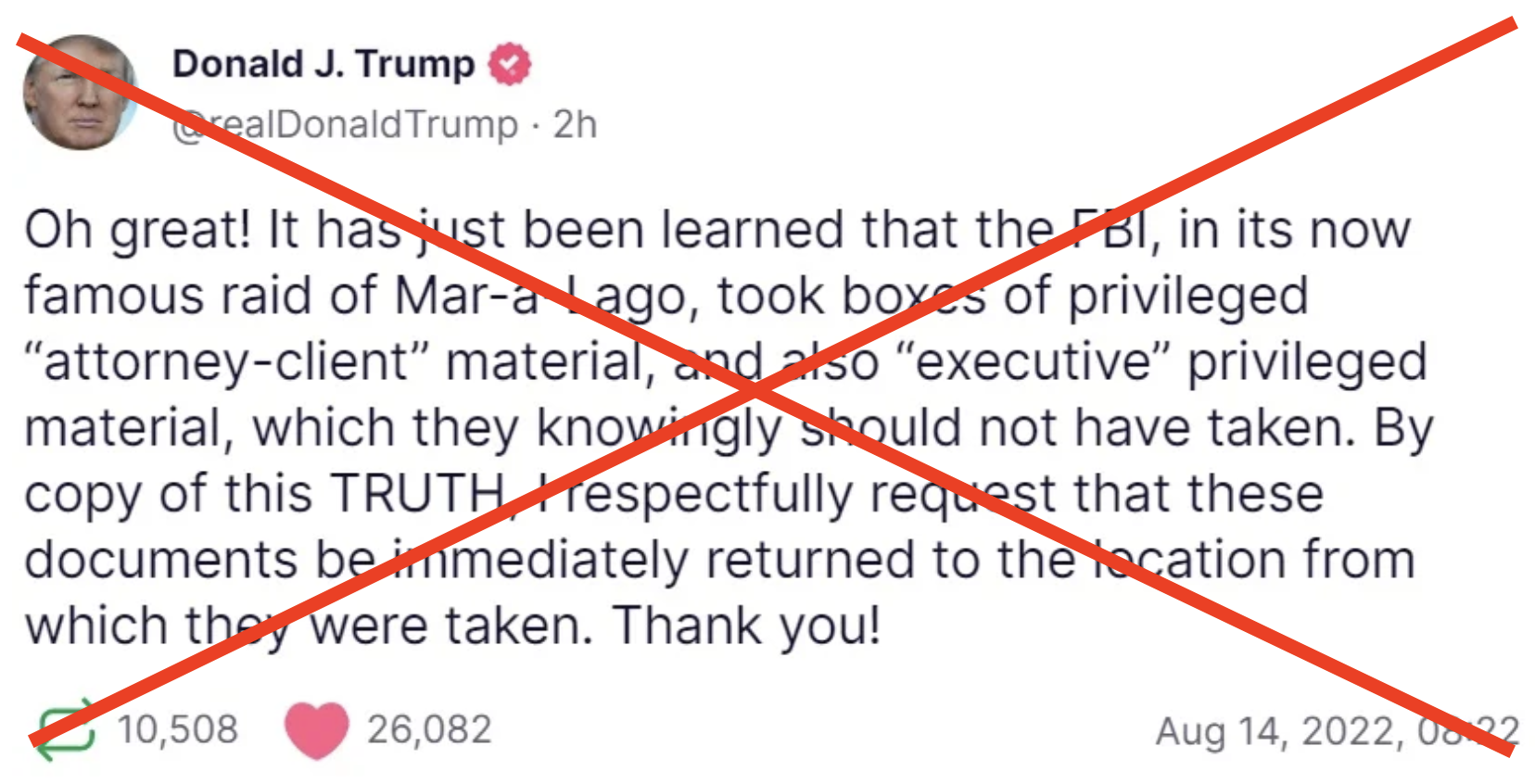


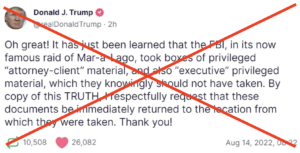
![[Photo: National Security Agency, Ft. Meade, MD via Wikimedia]](https://www.emptywheel.net/wp-content/uploads/2017/08/NationalSecurityAgency_HQ-FortMeadeMD_Wikimedia.jpg)
